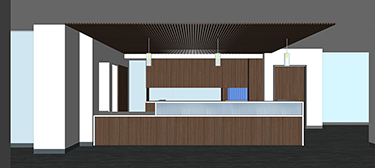|
Subscribe / Renew |
|
|
Contact Us |
|
| ► Subscribe to our Free Weekly Newsletter | |
| home | Welcome, sign in or click here to subscribe. | login |
Construction
| |
 |
July 23, 2015
New clinic at Swedish will treat patients who suffer from chronic pain
Mas Architecture

Jamieson
|
Chronic pain affects more than one might think. For many people, chronic pain can negatively impact their mood and their ability to function, work and participate in their lives.
With a growing awareness of the undertreatment of chronic pain, skyrocketing costs of what is often less-than-optimal treatment interventions, and a growing abuse of prescription pain medications, patients, payers and hospitals are looking for better long-term solutions.
An important shift from techniques focused primarily on eliminating pain to a more holistic team approach has emerged emphasizing the biologic, psychological and social consequences of a patient’s pain experience. Swedish Medical System is looking to provide more solutions for its patients.
Swedish Medical Center is relocating its long-established Pain and Headache Center, a clinic that has provided traditional pain services offered in most hospital settings, to a more comprehensive center with more collaborative, team-based pain rehabilitation programs.
A rebirth is now seen with the development of a new home and name for Swedish pain medicine, Swedish Pain Services, which is set to open in a 12,500-square-foot space on July 27.
This renewed vision comes from medical director of Swedish Pain Services, Steven Stanos. His focus is to provide patients with a “biopsychosocial” assessment and team-based management programs in addition to state-of-the-art injection therapies and an expanding role for complementary and alternative medicine, such as acupuncture and mind-body medicine.
The new clinic will comprise two distinct areas. One, a Pain Management center, which is a traditional clinic environment with exam rooms, injection suites and infusion bays. Second, a Functional Restoration center, which will provide highly integrated space for structured multiple-hour-per-day outpatient care, incorporating physical and occupational therapy, relaxation training and psychological counseling. Also included within the clinical site is studio therapy space for group discussions, educational classes, family meetings, movement-based therapies and aerobic exercise.
Over the last decade or so, health care design has focused on flexibility of design to accommodate future uncertainties, whether it be new treatments, technologies, procedures or equipment. Emphasis has been on creating the universal room, designed to host a wide range of future uses, and in most instances this approach has been effective. This pain clinic, however, required special consideration for its unique combination of services and dynamic, complex patient population.
A focus on atmosphere
After some of the first user group meetings, it was clear that the one-size-fits-all approach simply was not going to work. Our team went beyond the traditional task of listing room types and square footages and really focused on the atmosphere that would create the best patient experience for each type of therapy, not only on a room-by-room basis, but the clinic as a whole.
Pain Management maintains a traditional clinic atmosphere where a universal exam room made sense. All rooms are configured the same and are similar to other Swedish musculoskeletal clinics to allow providers to transition easily between clinics.
Patients and visitors are greeted in a central location. New evaluation patients are guided to one side of the clinic and patients receiving X-ray-guided injections, infusion therapies treatments and device management are escorted to another area. Careful attention was paid to lighting and sound control, particularly in the infusion bays, as this treatment can last for several hours.
Functional Restoration is a comprehensive program where patients can be in clinic for several hours at a time to even a full day, rotating through various activities. The desire was to create a more social atmosphere where people feel energized and engaged in their treatment.
Incorporating interactive areas for patients to gather between sessions became an important part of the program. Space for personal belongings is necessary, but a place for people to relax and have informal conversation is also a key feature in creating a supportive, collaborative environment that encourages patients to share their issues, challenges and successes.
The physical environment had to be conducive to the planned activities. We started with the industry standards for outpatient facilities, but the team felt that additional details were needed to provide the right atmosphere for each space. Sound control rose to the forefront of the discussion.
Relaxation therapy uses special equipment to monitor heart rate and breathing, and is best performed in a space with minimal sound interruptions and outside stimuli. To create this environment, walls that typically would merely penetrate the ceiling and use insulation and sound masking to achieve required acoustic levels were extended further and constructed with extra thickness to minimize the infiltration of external noise.
In addition to traditional room lighting for intake purposes, dimmable indirect lighting was added to promote calmness during treatment and eliminate any bright spots that might cause disturbance. A similar environment was created for the acupuncture rooms.
Private surroundings
Behavioral therapy, which includes one-on-one and group psychological counseling, has an increased focus on patient privacy and staff safety. Ambient noises might create a feeling of being overheard and discourage patients from fully expressing their thoughts and issues.
Surrounding walls are full height, and ceilings have higher acoustic qualities than typical ceilings. The room layout positions the provider in a place best suited for personal one-on-one interaction with the patient, but also for easy access to the door, promoting a sense of security.
The studio therapy area is a flexible space designed to function in multiple capacities. The space can support large conference or educational activities with full video conferencing capabilities or be divided into two smaller rooms for group sessions with multiple patients and caregiving teams.
Storage space is available for exercise mats and equipment for motion therapies. Multipurpose flooring was used as well as thicker wall construction to allow for the variety of uses and to isolate sound. The physical therapy gym is also a multipurpose space with mat tables, parallel bars, weights, mirrors and open exercise space.
Swedish Pain Services’ new space is the next step in its endeavor to treat patients’ pain issues holistically, offering a variety of services tailored to each patient’s needs. As the program expands, the hope is that there will be more types of therapies available and increased access for a growing number of patients of all ages to better manage their pain, improve their function and increase their quality of life.
Marguerite Jamieson is the senior medical planner at Mas Architecture with over 20 years of experience creating thoughtfully planned and designed health care spaces. Jamieson served as project manager and medical planner for Swedish Pain Services.
Other Stories:
- Hospital addition zeroes in on better patient care
- High-tech lights can aid patients by mimicking the effects of nature
- What we’ve learned about making hospitals better for seniors
- It’s never too early to consider tech in your nursing home project
- Vacant big-box store finds new life as Children’s clinic
- Whidbey hospital’s hyper-efficient HVAC system may be the first of its kind here
- How a pharmacy was designed to limit exposure to toxic drugs
- The way we design health care projects is changing in a big way
- Hospice brings comfort to dying patients



